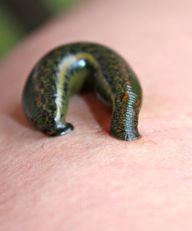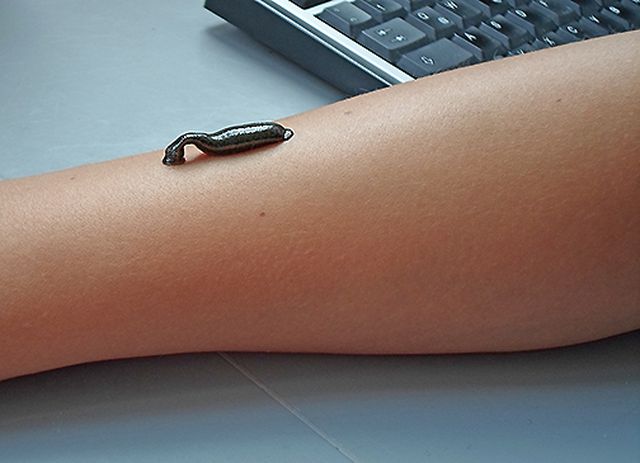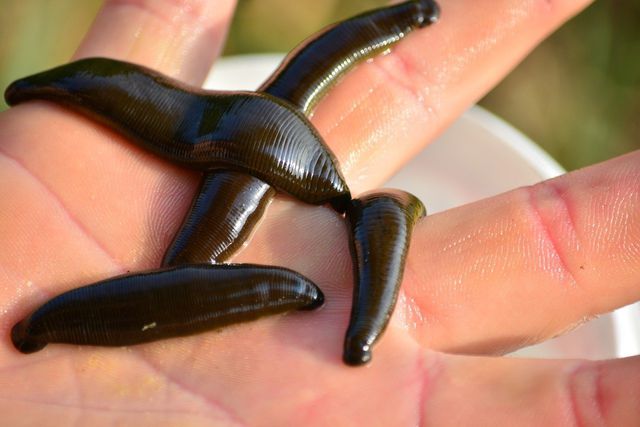
Leech therapy is considered a traditional healing method. You can read here what is behind it, how it works and whether it helps.
The origin of leech therapy
The leech, with a medical name Hirudo medicinalis, is a relative of the earthworm and is under the protection of the Washington Agreement. In the wild, it is considered endangered speciesbecause many of the animals were collected for treatment and the stocks were reduced so much.
Leech therapy is more than 2000 years old traditional healing method in medicine and a common treatment for chronic pain syndromes in European, Arabic and Asian naturopathy. Leech therapy was used in ancient Egypt and medieval Europe.
Leech therapy: use, procedure and side effects

(Photo: CC0 / Pixabay / EllWi)
For this, leech therapy is used
Leeches are usually five to eight centimeters long and grow when Start to two to three times the size. The saliva contains the leech anti-inflammatory substances like hirudin, supposed to soothe the pain.
Leech therapy is used as an alternative to surgery for several diseases demonstrably successfully applied – however, in some studies methodological shortcomings detected:
- Diagnosis of chronic lower back pain
- Gonarthrosis
- Phlebitis
- Hematomas
- boil
Also in the Dentistry can leeches for Pain relief and at Inflammation can be used in the mouth.
Also Animals can use leech therapy for certain symptoms, for example:
- Arthritis / arthrosis
- Diseases of the tendon and ligamentous apparatus
- Spinal disorders
- Inflammation of the nerves
- Muscle hardening
- Eczema and abscesses
- Venous and dental diseases
The possible applications for humans and animals are similar.
This is how leech therapy works
The leeches are in the affected, mostly inflamed, place scheduled. They cut a small wound in the skin and soak up blood. It takes about an hour or two to get sucked up and fall off on their own. Then the miracles are cared for. It feels like a mosquito bite to the patient.
Side effects of leech therapy
In addition to rebleeding, leech therapy can also Side effects occur. This includes:
- local itching
- Swelling of the wound
- local lymph node swelling
- occasionally local allergic reaction
A leech can only be used medically once. Likewise, reuse on the patient is not permitted due to the risk of infection that cannot be excluded.
Leech breeding: guidelines for ensuring quality and safety



(Photo: Sarah Klemm)
There are various breeding stations for medical leeches in Germany, such as the one Biebertal leech breeding. It has been certified for the rearing, keeping and distribution of pharmaceutical leeches since 2009 and also offers training and publication of specialist information.
The Federal Institute for Drugs and Medical Devices has Guidelines published to ensure the quality and safety of leeches in human medicine. They stipulate that leeches are medicinal products in accordance with Section 2 Paragraph 1 of the Medicinal Products Act (AMG) are. We, too, are informed about the risks of infection and they contain guidelines that must be followed for quality assurance in leech therapy.
The message is aimed at leech breeders, distributors and leech users. Breeders and distributors are also encouraged to submit experience reports on the implementation of the guideline to the Federal Institute.
Cost of leech therapy



(Photo: CC0 / Pixabay / Stones)
The costs of leech therapy are to be discussed individually with the treating alternative practitioner / doctor and paid directly to them:
- 4 to 6 leeches are placed on the skin.
- Cost: about 20 to 44 euros per session, plus costs for the animals.
- This is what the statutory health insurance companies pay: Medicines for pain and inflammation, physiotherapy, acupuncture, surgery
So it is considered Self-payer benefit. in the IGeL monitor leech therapy is classified as “tending to be negative” because no benefits but even minor damage from side effects could be analyzed.
Leech therapy and animal welfare
Leech therapy is controversial among medical professionals. On the one hand, leeches are protected because they have become rare in natural habitats. On the other hand, they are bred for single use. The animals for breeding are allowed not reused become. They must comply with the regulations of the federal and state governments for waste disposal, in particular the Directive about the proper disposal of waste from healthcare facilities. This means that leeches, such as disposable items, have to be disposed of immediately by healthcare providers.
The Bibertaler leech breeding, on the other hand, enables after leech therapy Withdrawal of medical leeches under certain hygienic conditions and releases them after an 8-month quarantine in a so-called pensioners’ pond.